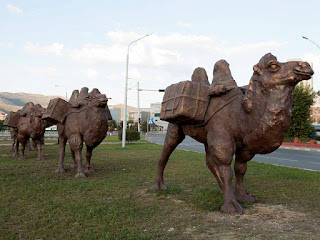Mongolia | Ulaanbaatar | Camel Statues
The other day my pal Saka and I went shopping. As we were sitting in a line of traffic backed behind the traffic light at the intersection of Chingis Khan Avenue and the Zaisan Tolgoi road I noticed looming above the tops of cars in front of us a statue of a camel that had recently been installed in a traffic island in middle of the avenue. From our angle only the head of what I thought was one of two camels was visible.
“Did you see the statues of the two camels?” I asked Saka. “That’s a great idea. I wonder who is responsible for them?”
“There is only one camel, replied Saka.
“No,” I replied, “there are two camels. You just can’t see the other one from here. I hope they install a whole string of them.”
“I just drove by there on my way to your apartment, and there is only one camel there,” she insisted.
“There are two,” said I, “do you want to bet on it?
“I don’t bet, but you are wrong; there is only one.”
“No sorry, you are wrong.”
The light changed and we drove by the traffic island. There was only one camel. Saka almost peed her pants laughing (she’s easily amused). “And you wanted to bet! Hahahaha (or khikhikhikhi, as Mongolians write it). I should have bet you a hundred dollars! I could buy a new handbag!”
I was completely flummoxed. The bus I take to town goes right by this traffic island and I had noticed when they had installed the first camel. I said to myself, “wouldn’t it be a great idea to install a whole string of camels.” Then about a week ago I took a bus to town and we got struck in line of cars right in front of the traffic island. I could not help but notice that another statue had been installed. Now there were two of them. We sat there for at least five minutes in the traffic jam and I stared at the two camels the whole time. The image of two camels was indelibly imprinted in my mind. I also thought, “Since there are now two camels maybe they are going to install a whole string of them. I certainly hope so.” Now, inexplicably, there was only one camel. Had I hallucinated the second camel? It seemed unlikely.
Five days later I took the bus to town again. Now there was indeed a string of camel statues on the traffic island; in fact, five of them. Instead of going straight into town I got out at the nearest bus stop and took photos of all five camel statues before any of them could disappear.
Three of the string of five camel statues (click on photos for enlargements)
One of the camel statues
I don’t know who is responsible for the camel statues, but they should be heaped knee deep in laurels to this wonderful tribute to the Most Noble Of All Four-Legged Animals. The statues serve to remind not only residents of the city but visitors who will drive right by them when arriving from the airport that Ulaanbaatar was once the nexus of numerous caravan routes running south to Beijing and Lhasa and other cities in China; west to Urumqi in Xinjiang Province, China; from hence to Samarkand, Bukhara, Tabriz, and other great cites of the Silk Road; and north to Irkutsk in Siberia, which was once the northern terminus of the Tea Road between China and Russia. Camels were the main mode of transportation on all of these routes.
Camels on the Old Caravan Route to Tibet in Gov-Altai Aimag
As I stood by the camel statues I could not help but think of the great Buryat lama Agvan Dorzhiev, who made the fastest recorded trip from Ulaanbaatar (then called Ikh Khüree [Их Хүрээ] = “Great Settlement”, or Örgöö [Өргөө] = “Palace”) to Lhasa by camel. Leaving the city on December 5, 1900 on an urgent diplomatic mission to the 13th Dalai Lama, Dorzhiev and his party had traveled day and night and arrived in Lhasa seventy-two days later. Normal caravans took four or five months. What I wouldn’t give to have been on that trip!
Agvan Dorzhiev (1854–1938)
I was also reminded of a ensemble of camel statues I had seen on Lyab-i-Haus square in Bukhara, Uzbekistan. The Bukhara Ensemble also honors the caravan men who accompanied the camels. Shouldn’t the caravan men be likewise honored in Ulaanbaatar?
Camel Ensemble in Bukhara
Camel in Bukhara
Camel Man in Bukhara
Anyhow, I stick by my claim that there were at one time two camels standing alone on the traffic island in Ulaanbaatar. I think one was installed, then the second one, but for some reason this second one was temporarily removed—maybe it had been damaged. Then it and three more statues were installed for a total of five. Either that, or while I was sitting in the bus that day in a traffic jam in front of the statues I entered a time warp into a future where there were two camels, but then returned to the mundane time-space continuum where my friend Saka and I later saw only camel. Those are the only two possible explanations.









